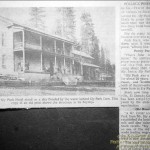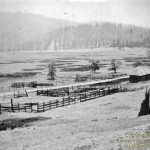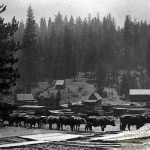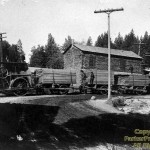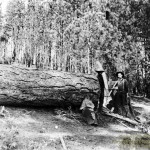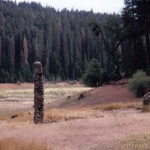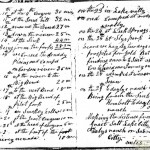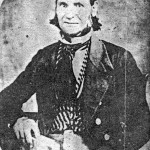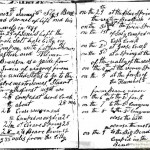Sly Park, noted for its beautiful surroundings, has always been a favorite stopping place. Before Jenkinson Lake came to be, the area was a large, flower covered meadow with spring fed streams. The Maidu and Miwok people came there in the summer and fall to hunt and gather food. The women ground the acorns from the black oak trees found in abundance there. They chose the south facing slope overlooking the meadow and creek. The large rock outcroppings were in a perfect location and are now pockmarked from the years of grinding. Hundreds of grinding holes can be seen when the water is low.
In 1848 the Mormon Battalion, who had served in California as a peacetime force during the Mexican War, were called back to Salt Lake City by Brigham Young. While waiting for the snow to melt, they worked for John Sutter at the Coloma saw mill and at his flour mill down river. When gold was discovered, they decided to try their hand on their days off. They had some luck at the flour mill location, and it became known as Mormon Island. When spring came, they chose a spot in the El Dorado foothills to wait for the wagons to assemble for the trip to Salt Lake. They called this place Pleasant Valley. While waiting there, three men decided to scout ahead for a pass through the snow covered peaks to the east. This was the pass explored by Kit Carson and John Fremont on their expedition in 1844.
On July 2, 1848, the group of 45 men, 1 woman (a sergeant’s wife), 17 wagons, 150 horses and 150 cattle began to move up the divide between the American and Cosumnes rivers. The company stopped after a couple of days in a lush green valley, “which we called Sly’s Park after one of our men who found it, and there built a couple of corrals.” (This is taken from Bigler’s Chronicles of the West.)
At that point they sent out 10 men to explore the anticipated route and to look for the three men from whom they had received no word. The others waited and grazed their stock in the rich meadow grasses for about 9 days.
The scouting party returned, having seen nothing of the three men, but they had discovered a pass that would have to be cleared. The company cut brush and rolled rock, traveling about eight miles a day. The first night out of Sly’s Park, they camped at what they called Camp Creek. The second night was spent at Leek Springs, named for the many leeks about it.
Five of the men went on ahead to cut the road. They came across a place by a large spring where it appeared their three advance scouts had camped. Nearby was a fresh grave, and here they found the three men murdered and buried in a common grave. This place they called Tragedy Springs. Many of the place names of the Sly Park area can be attributed to that Mormon trek. James Calvin Sly returned to Sacramento from Salt Lake City over the same road about a year later as a guide for a train of wagons. They stopped at Sly’s Park for two days prospecting for gold, according to his journal.
The earliest known settlers in Sly Park were Hiram O. Bryant and William Stonebreaker, who on June 24, 1853, each claimed 160 acres of adjoining land (just east of the present main dam) for agriculture and grazing. They built houses and outhouses and the place became known as Sly Park Ranch. The Stonebreakers and Bryants sold the ranch and settled just east of Sly Park.
Luther C. Cutler and two partners bought Sly Park Ranch in November of 1857. Cutler bought out his partners and continued to buy parcels of land in the meadow. Mr. Cutler built a sawmill there and sold one half interest in the sawmill to Louis Lepettit in 1863. The mill was on Sly Park Creek on the east side of the road to Stonebreaker. There was a ditch and a flume to provide water to run the mill. On June 4, 1875, Luther Cutler bought Hazel Valley Ranch from Sam Kyburz for $100; bounded north and west by Cutler’s property, south by Sly Park Creek, and east by vacant land.
The meadow was a favorite stopping place for ranchers driving their stock to the upper mountain ranges to graze for the summer and fall. About 20,000 head of cattle and 10,000 head of sheep might be driven through Sly Park Valley in a year. The industrious Mr. Cutler established a two story frame hotel with 15 rooms, a dormitory to accommodate 15 to 20 men, a dining room and a bar. A small post office building adjoined the hotel on the east. The cattlemen as well as teamsters and other travelers all were accommodated at the hotel. There were two large dance platforms where dances were held nearly every Saturday night. George Holcomb played the violin, and Robert Carmichael played the banjo and harmonica at the same time.
Henry Alfred Stark was adopted by Mr. Cutler, according to Stark’s son Park. The man who built Stark’s Road was an uncle to Henry Stark. Henry was born in Mud Springs (now called Diamond Springs). He owned some property and mining rights in that area in the 1870’s.
Luther C. Cutler died on January 17, 1882, in Alameda County, although he was a resident of El Dorado County. He had no wife or children and left his estate to his two brothers and one sister and Henry A. Stark. The ranch in Sly Park he left to Henry Stark with the condition that he could use and occupy it throughout his lifetime, but could never sell it or any part of it. If Henry Stark married, the land would go to the children of that marriage at the time of Henry Stark’s death, to share and share alike. If he had no children, the property would then go the siblings of Luther Cutler or their heirs. Henry Stark was also left other land, but the rest of the estate was sold and divided equally between Henry Stark, Cutler’s brothers, Thomas and Sanford, and Cutler’s sister, Hannah G. Ford. This amounted to nearly $2000 each.
In 1882, Henry Alfred Stark married Mary M. Carmichael, who was born in Smith Flat. They moved to Sly Park and had three children; Park Cutler Stark, Henry Elmer Stark, and Hazel Alma Stark. The Starks operated the ranch, dairy, hotel, and later a store, most of their lives. Park was 12 years old when his Father died in 1898, leaving Sly Park Ranch to Mary Stark and the three children. The will stated, “Work horses, Barney, Eva, Craly, and Gray Mare, 4 colts, 7 cows, 10 calves, 4 hogs, 1 spring wagon, 1 plow, 1 mowing machine, 2 harnesses, a 4 bedroom residence, dining room and kitchen furniture, 1 sewing machine, and accounts due. The property was sold to E. I. D. on July 13, 1927.
Henry Schneider was a pioneer of the Pleasant Valley area. He had a butcher shop there and drove a two horse butcher wagon every day from Pleasant Valley to the various saw mills east of Sly Park. He would go down to Camp Creek, cut a willow pole, and catch about 150 trout in about 2 hours, according to Park Stark. Perhaps this is the Schneider that rented the Sly Park Ranch from El Dorado Irrigation District. The Schneiders would use it as a stopover when taking the cattle to Silver Lake. They had about 1000 head and would bring them to the Stark ranch. They took one bunch up to Silver Lake, then come back to get the second bunch. Sly Park Ranch at this time consisted of a 2 story house, a milk house, and a barn. There was a root cellar dug into the hillside behind the house. A spring also was located behind the house. The foundation of the house can still be seen when the water is low. The Carbines would stay in the house and look after the place off and on.
In September of 1889 Charles and Mary Farette sold 2 pieces of property to the Sly Park School District for $10. This property was located just west of where the lake now narrows. Due to the many mills in the area, there was need for a school there for many years. The school property was sold in 1927, but Sly Park School District had a school at Fresh Pond until the school district merged with the Pollock Pines School District.
The Blairs had a mill at Sly Park from 1890 until 1908. It was a large operation employing many mill workers. It was located in the valley just east of where the dam is now located. There had been and were mills dotting the surrounding area. In the Hazel Valley there was a Phippins Mill and later a Hazel Valley Mill. Placerville Lumber Company also had a mill there at one time.
The Carbines that cared for The Sly Park Ranch had been lumbermen in the area for 3 generations. Mike Carbine now lives on the old Casey place just west of Sly Park. In the 1940’s he hauled logs from the American River Canyon up Forebay Road to the Trotoshaw Mill on North Street. His father, John “Edward” Carbine, started driving a 12 bull ox team to pull logs to Blair’s Mill at Sly Park when he was 12 years old. Mike’s grandfather, Michael Sullivan Carbine hauled lumber from Blair’s Mill at Sly Park to Placerville.
The El Dorado Irrigation District had been in desperate need of new water sources. They had been considering Hazel Valley and Sly Park for some time. Property was purchased there in 1927 with the idea of putting a dam on the creek in Hazel Valley. With the onset of the great depression, these plans had to be scrapped for lack of finances. The water shortage didn’t cease however, and government help was requested and denied. In 1944 Walter E. Jenkinson, Secretary-Manager of the district, asked the United States Bureau of Reclamation to make a study of its water problems. The studies indicated that the Sly Park project was the most feasible plan, but the districts ability to pay for it was in question.
Congressman Clair Engle was asked to help with the districts water problem. About that time the Central Valley Project was studying the proposal of a dam at Folsom that would benefit down-stream counties. Congressman Engle conceived the idea that upstream counties should be helped as well as the downstream counties and presented legislation H R 165, which was passed in 1949, authorizing the United States Army Corp of Engineers to construct Folsom Dam, and the United States Bureau of Reclamation to construct Folsom Power Plant, Nimbus Dam and the Sly Park Project as part of the Central Valley Project
In 1951, after 27 years of effort, the Bureau of Reclamation began to clear the area and build Sly Park Dam. Storage of water was started in November, 1954, and the resulting 41,000 acre feet capacity lake was named after Walter Jenkinson who persevered to make it a reality. The project consists of 3 dams. One on upper Camp Creek, perhaps the same area as fished by Mr. Schneider. The water from here is diverted through a 2855 foot tunnel 7 feet in diameter into upper Park Creek. The main Sly Park Dam is 190 feet high and 760 feet long. The saddle dam is 130 feet high and 600 feet long. Park Creek flows into the upper end of the lake and exits below the dam emptying into Camp Creek further downstream.
The chimneys in the eastern portion of the lake are said to be remnants of a house started by a Mr. Bishop in 1911. On August 1, 1911, Allen Bishop and Harvey P. Goodman bought 320 acres of land in Hazel Valley, including the buildings that were on it, for $10. Allen Bishop listed himself as a capitalist in the 1912 voter registration. His capital ran out and he sold the house. The house was located near the Phippins Mill. Placerville Lumber Company later bought Phippins Mill.
When the land was cleared in about 1950 to begin the Sly Park Dam Project, about 15 cabins from the Placerville Lumber Company mill compound were sold to brothers John and Frank Krek. Frank was a millwright in the mill there. John is the father of John and Richard Krek, who both work for the Pollock Pines-Camino Fire Department. The cabins were transported by logging truck to Lake Tahoe for resale. Some of the lumber from the other mill buildings was used in other houses in the area. John and Richard’s maternal grandfather, Lester Kline, was the first guard at the gate when Sly Park Campground was opened.
Sly Park Campground and Recreation Area is owned by the Bureau of Reclamation, but operated by the El Dorado Irrigation District. The lake is kept stocked with fish by the California Department of Fish and Game. Since Pollock Pines and the surrounding area still thrive on the tourist trade, Sly Park and Jenkinson lake are a very important part of our economy.
All images for this chapter, and additional photos not in the original book are shown below.
Photo Gallery for Sly Park
- Blair Mill at Sly Park
- Lumber from Blair Mill at Sly Park arriving at Blair Lumber Store
- Logging for Blair Mill at Sly Park
- Sly Park Hotel with the adjoining post office on the right
- Chimney’s left standing in the eastern portion of Jenkinson Lake
- The Stark Ranch at Sly Park (Picture courtesy of E.I.D.)
- James Calvin Sly 1849 Diary – Page 1-2
- James Calvin Sly
- James Calvin Sly 1849 Diary – Page 1-2

